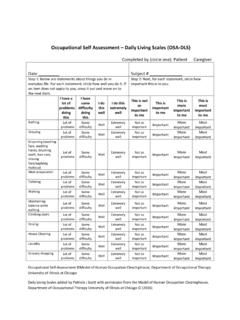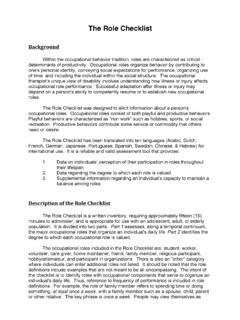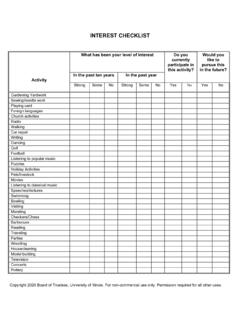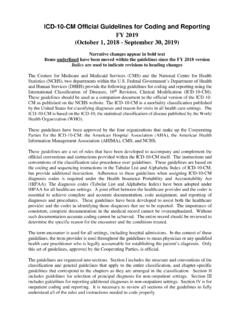Transcription of OCCUPATIONAL QUESTIONNAIRE - MOHO Web
1 B:\OCCQUES\ \November 16, 1993\March 7, 2004 OCCUPATIONAL QUESTIONNAIRED eveloped by N. Riopel Smith with assistance from G. Kielhofner and J. Hawkins Watts (1986).1 INSTRUCTIONS:In this QUESTIONNAIRE you will be asked to record your usual daily activities, and to answer some questions about these ONE:Please think about how you have been spending your days the past few weeks. Try to decide what you do on a usual weekday (Monday - Friday). Using the worksheet that begins below, record your activities from the time you wake up. Each row represents a half hour. For each half hourrecord the main activity that you would be doing during that half hour. An activity can be anything from talking to a friend, to cooking, to bathing. If you do an activity for longer than a half hour, write it down again for as long as you continue to do that TWO:After you have listed your activities, answer all four of the questions for each activity by circling the number of the most appropriate answer.
2 Notice that the questions ask you to consider whether your activities are work, daily living tasks, recreation, or rest, and to consider how well you dothe activities, how important they are to you, and how much you enjoy them. In the first question, work does not necessarily mean that you arepaid for the activity. Work can include productive activities that are useful to other people, like volunteering at a hospital. Daily living tasks areactivities that are related to your own self care, such as housekeeping and shopping. Rest includes taking a nap and not doing anything in particular. Even if a question does not seem appropriate for some of your activities, please try to respond to each one as accurately as possible. Your answersto every question are important! 1 This instrument was first published in: Smith, , Kielhofner, G., & Watts, (1986).
3 The relationships between volition, activity pattern, and life satisfaction in the elderly. American Journal of OCCUPATIONAL Therapy , 40 , 278-283. B:\OCCQUES\ \November 16, 1993\March 7, 2004 OCCUPATIONAL QUESTIONNAIRED eveloped by N. Riopel Smith with assistance from G. Kielhofner and J. Hawkins Watts (1986).Today's date Name Age TYPICAL ACTIVITIESFor the half hour beginning at:QUESTION 1I consider this activity to be:1 - work2 - daily living work3 - recreation4 - restQUESTION 2I think that I do this:1 - Very well2 - Well3 - About average4 - Poorly5 - Very poorlyQUESTION 3 For me this activity is:1 - Extremely important2 - Important3 - Take it or leave it4 - Rather not do it5 - Total waste of timeQUESTION 4 How much do you enjoy this activity:1 - Like it very much2 - Like it3 - Neither like it nor dislike it4 - Dislike it5 - Strongly dislike it5:00 am 1 2 3 4 1 2 3 4 5 1 2 3 4 5 1 2 3 4 55.
4 30 1 2 3 4 1 2 3 4 5 1 2 3 4 5 1 2 3 4 56:00 1 2 3 4 1 2 3 4 5 1 2 3 4 5 1 2 3 4 56:30 1 2 3 4 1 2 3 4 5 1 2 3 4 5 1 2 3 4 57:00 1 2 3 4 1 2 3 4 5 1 2 3 4 5 1 2 3 4 57:30 1 2 3 4 1 2 3 4 5 1 2 3 4 5 1 2 3 4 58:00 1 2 3 4 1 2 3 4 5 1 2 3 4 5 1 2 3 4 58:30 1 2 3 4 1 2 3 4 5 1 2 3 4 5 1 2 3 4 59:00 1 2 3 4 1 2 3 4 5 1 2 3 4 5 1 2 3 4 59:30 1 2 3 4 1 2 3 4 5 1 2 3 4 5 1 2 3 4 510:00 1 2 3 4 1 2 3 4 5 1 2 3 4 5 1 2 3 4 510:30 1 2 3 4 1 2 3 4 5 1 2 3 4 5 1 2 3 4 511:00 1 2 3 4 1 2 3 4 5 1 2 3 4 5 1 2 3 4 511:30 1 2 3 4 1 2 3 4 5 1 2 3 4 5 1 2 3 4 512:00 1 2 3 4 1 2 3 4 5 1 2 3 4 5 1 2 3 4 5B:\OCCQUES\ \November 16, 1993\March 7, 2004 OCCUPATIONAL QUESTIONNAIRE (CONTINUED)TYPICAL ACTIVITIESFor the half hour beginning at:QUESTION 1I consider this activity to be:1 - work2 - daily living work3 - recreation4 - restQUESTION 2I think that I do this.
5 1 - Very well2 - Well3 - About average4 - Poorly5 - Very poorlyQUESTION 3 For me this activity is:1 - Extremely important2 - Important3 - Take it or leave it4 - Rather not do it5 - Total waste of timeQUESTION 4 How much do you enjoy this activity:1 - Like it very much2 - Like it3 - Neither like it nor dislike it4 - Dislike it5 - Strongly dislike it12:30 pm 1 2 3 4 1 2 3 4 5 1 2 3 4 5 1 2 3 4 51:00 1 2 3 4 1 2 3 4 5 1 2 3 4 5 1 2 3 4 51:30 1 2 3 4 1 2 3 4 5 1 2 3 4 5 1 2 3 4 52:00 1 2 3 4 1 2 3 4 5 1 2 3 4 5 1 2 3 4 52:30 1 2 3 4 1 2 3 4 5 1 2 3 4 5 1 2 3 4 53:00 1 2 3 4 1 2 3 4 5 1 2 3 4 5 1 2 3 4 53:30 1 2 3 4 1 2 3 4 5 1 2 3 4 5 1 2 3 4 54:00 1 2 3 4 1 2 3 4 5 1 2 3 4 5 1 2 3 4 54:30 1 2 3 4 1 2 3 4 5 1 2 3 4 5 1 2 3 4 55:00 1 2 3 4 1 2 3 4 5 1 2 3 4 5 1 2 3 4 55:30 1 2 3 4 1 2 3 4 5 1 2 3 4 5 1 2 3 4 56:00 1 2 3 4 1 2 3 4 5 1 2 3 4 5 1 2 3 4 56:30 1 2 3 4 1 2 3 4 5 1 2 3 4 5 1 2 3 4 57.
6 00 1 2 3 4 1 2 3 4 5 1 2 3 4 5 1 2 3 4 57:30 1 2 3 4 1 2 3 4 5 1 2 3 4 5 1 2 3 4 58:00 1 2 3 4 1 2 3 4 5 1 2 3 4 5 1 2 3 4 58:30 1 2 3 4 1 2 3 4 5 1 2 3 4 5 1 2 3 4 59:00 1 2 3 4 1 2 3 4 5 1 2 3 4 5 1 2 3 4 59:30 1 2 3 4 1 2 3 4 5 1 2 3 4 5 1 2 3 4 510:00 1 2 3 4 1 2 3 4 5 1 2 3 4 5 1 2 3 4 510:30 1 2 3 4 1 2 3 4 5 1 2 3 4 5 1 2 3 4 511:00 1 2 3 4 1 2 3 4 5 1 2 3 4 5 1 2 3 4 511:30 1 2 3 4 1 2 3 4 5 1 2 3 4 5 1 2 3 4 5B:\OCCQUES\ \November 16, 1993\March 7, 2004 Bibliography on the Model of Human Occupation(Published Works on Instruments)The OCCUPATIONAL QuestionnaireBarris, R.
7 , Kielhofner, G., Burch, , Gelinas, I., Klement, M., & Schultz, B. (1986). OCCUPATIONAL function and dysfunction in three groups of adolescents. OCCUPATIONAL Therapy Journal of Research, 6, , , Coster, W., & Duncombe, L. (1989). Comparison of normal and psychosocially dysfunctional male adolescents. OCCUPATIONAL Therapy in MentalHealth, 9(2), , G., & Brinson, M. (1989). Development and evaluation of an aftercare program for young and chronic psychiatrically disabled adults. OCCUPATIONAL Therapy in Mental Health, 9(2), , K., Barris, R., & Hooper, F. (1987). Use of the model of human occupation to predict women s exercise behavior. OCCUPATIONAL Therapy Journal ofResearch, 7, , N., Kielhofner, G. & Watts, J. (1986). The relationship between volition, activity pattern and life satisfaction in the elderly. American Journal ofOccupational Therapy, 40, , L. Barris, R., & Kielhofner, G. (1985).
8 The model of human occupation applied to psychosocially functional and dysfunctional adolescents. OCCUPATIONAL Therapy in Mental Health, 5(1), 21-40.



